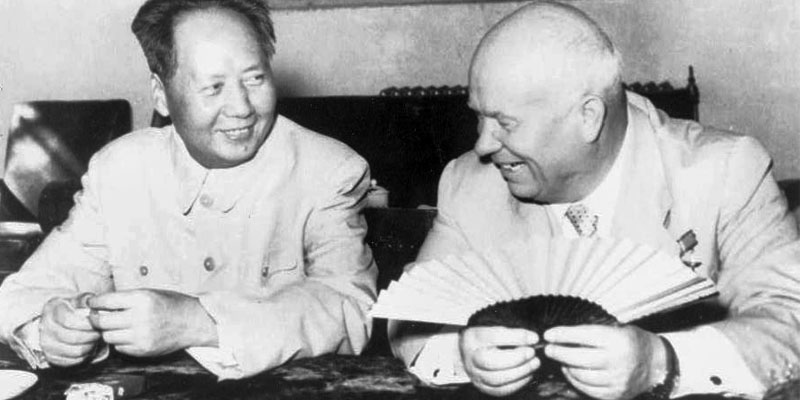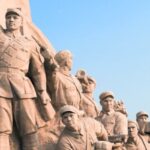We explain what the non-Soviet rupture was and why Mao Zedong and Nikita Jrushchov faced. In addition, its main consequences.

What was the Sino-Soviet rupture?
It is known as a sin-soviet rupture to the ideological and political conflict between the People's Republic of China and the Soviet Unionin the 1950s and 1960s. Both countries were governed by communist parties and in 1950 they had signed an alliance to strengthen their political and economic position worldwide. However, a few years later his link began to deteriorate in his competence for international influence and finally, in 1962, China and the USSR broke relationships.
When the dispute began, the Chinese Communist Party (PCCH) was led by Mao Zedong and the Communist Party of the Soviet Union (PCUS) by Nikita Jruscov. In 1956, the PCCH leadership repudiated the Soviet international policy that raised the peaceful coexistence with the western block, in the context of the cold war.
A few years later, The USSR refused to provide scientific and material advice for China to develop its nuclear program. Consequently, both countries began to accuse themselves publicly and seek support from the rest of the communist community.
Consequently, the international communist movement was weakened and The way for the new relations between China and the United States. In this way, the Sino-Soviet rupture became one of the most important events of the Cold War.

See also: Blocks of the Cold War
Background of the Sino-Soviet relationship
During the first half of the twentieth century, the relationship between the USSR and China was marked by different conflicts linked to territorial disputes. With the beginning of the Cold War, Iosif Stalin managed to consolidate the power and influence of the USSR as leader of the worldwide communist bloc. On the other hand, the 1949 Chinese revolution established a communist government in the hands of the Chinese Communist Party (PCCH) and led by Mao Zedong.
In this context, Both leaders sought to establish an alliance between their countries. The USSR would allow her to strengthen her place of leadership in the Eastern Block and the PCCH needed economic and material support to stabilize the political and economic situation of her country after the revolutionary process. However, the creation of the Sino-Soviet alliance was difficult.
The communist parties of both countries had a conflicting history, and the PCCH had faced the leadership of the Communist Party of the Soviet Union (PCUS) in the Communist International (the largest communist organization in the world).
The differences were substantial in terms of their ideological visions about how the structure of the organization should be, its political priorities and its strategies. While for Stalin the key to the communist expansion were the workers' organizations of urban factories, Mao defended the fundamental role of the peasantry and the rural base of the revolution.
However, beyond these differences, The USSR supported the PPCH during its revolution against the nationalists and Mao understood the importance of Soviet assistance to achieve power. Between 1937 and 1945, Mao maintained a close contact with the PCUS and continued, in many situations, Stalin's instructions. With the beginning of the Cold War, Stalin directly supported the Chinese revolutionary action and attended the Communist Bank during the Civil War.
The Sino-Soviet alliance
When Mao managed to defeat the nationalists and obtained power in 1949, negotiations began to establish a Sino-Soviet alliance. However, Stalin and Mao had conflicting interests.
Stalin wanted to preserve a previous treatysigned with the nationalist government, in which Soviet economic interests were taken care of in the Northeast Chinese. For Mao, abolishing the old treaty was essential to legitimize the power of the PCCH in the government. On the other hand, in that context, Yugoslavia (one of the most important communist countries of the Eastern bloc) had been enmity with the USSR. Stalin feared losing his influence on the eastern block and was not sure of Mao's loyalty.
At the beginning of 1950, the PCCH sent the Minister of Foreign Affairs, Zhou Enlai, to take care of negotiations with the USSR. Zhou achieved the commitment of both parties.
Through the Sinovosta Treaty (1950), China promised to recognize the independence of Mongolia and allow the Soviets to maintain their privileges in Xinjiang and in the Northeast of China. In return, the USSR agreed to abolish the previous treaty, renounce its economic privileges in Manchuria and provide financial and military aid to China.
Causes of the Sino-Soviet Rupture
After Stalin's death in 1953, the new Soviet leader Nikita Jrushchov traveled to Beijing to strengthen her link with Mao and the PCCH. In the early years of his government, relations remained stable. Jrushchov even promised Mao, secretly, Soviet assistance to develop a nuclear program.
However, The Jrushchov government was based on two fundamental policies that were divergent to China's interests: the “deestalization” of the USSR and its relations with the eastern block and the “peaceful coexistence” with the western block. The PCCH opposed both policies and, especially, the relaxation of tensions with the United States.
The PCCH considered it important to achieve nuclear parity (Develop your own nuclear bomb so as not to remain at a military disadvantage against other powers) to consolidate its power internationally. With the initiative of the “peaceful coexistence”, the International Disarmament or Armament Limitation policy played against him.
In addition, he kept believing that communism could expand through the revolution in the rest of the world. This way, The PCCH defended the aggressive posture of enmity between the eastern block and the western block and accused Jrushchov's policies of revisionists (abandonment of Marxist principles).
The rupture process between the two communist giants was articulated in different steps:
- In 1958, the People's Republic of China bombed the islets of Quemoy and Matsu in the Strait of Formosa.
- Taiwan (the nationalist China of Chiang Kai Chek) was supported by the US and the USSR maintained a distant attitude. Mao accused PCUS of having become an ally of the United States.
- In 1959, Jrushchov and Mao gathered in Beijing. However, the negotiations were not good. Consequently, the Soviet scientists of the nuclear program were repatriated, Chinese migrants in the USSR had to return to their country and cooperation actions were interrupted.
The ideological conflict soon became a typical conflict between powers:
- In the border clash for the Tibet region between China and India in 1962, Moscow chose to support the New Delhi government.
- Mao accused the USSR of “capitulationist” after the missile crisis in Cuba in 1962.
- In 1964, popular China rehearsed its first atomic bomb, which gave the confrontation a new dimension.
- In 1969, bloody border incidents broke out in the usuri river.
Consequences of the Sino-Soviet Rupture
The enmity between both powers began to have effects on international policy. Through clashes in other territories, both the USSR and China sought to consolidate their influence. For example, when China and India met by Tibet (1962), the USSR supported the government of India.
This new situation was used by the United States, whose influence in Asia had been weakened by the Vietnam War. The successive US presidents Henry Kissinger and Richard Nixon visited Beijing in 1971 and 1972 and normalized relations between the two countries.
This way, The People's Republic of China obtained one of its most important political achievements internationally: He managed to enter as a permanent member of the UN Security Council, instead of Taiwan.
Finally, the arrival of Mikhail Gorbachev to the USSR government in 1985 improved relations between the two countries. However, the internal crisis of the USSR and communism internationally imposed itself definitively.
Before achieving normalization of relationships, The USSR collapsed and ended up dissolving. On the other hand, the Popular Republic of China emerged as the main communist power worldwide, due to the enormous economic growth that it achieved through its mixed economy and its international policy strategy.
Continue with:
document.addEventListener(“DOMContentLoaded”, (e) => {
var sliderContainer, slider;
sliderContainer = document.getElementById(‘block_0b9b7ca9a9d75b9fe55db9e2c1f91c36’);
if (typeof initSlider !== ‘function’) {
console.log(‘Swiper haven\’t been loaded’);
sliderContainer.className += ‘ fw scroll-snap’;
return;
};
options = {
direction: ‘horizontal’,
speed: 1000,
slidesPerView: ‘auto’,
// slidesPerGroup: 1,
centerInsufficientSlides: true,
// centeredSlides:true,
spaceBetween: 15,
breakpoints: {
720: {
// centeredSlides: false,
// slidesPerGroup: 2,
spaceBetween: 25
},
},
pagination: {
el: ‘.swiper-pagination’,
type: ‘bullets’,
clickable: true
},
}
slider = initSlider(sliderContainer, options);
})
ZHOU ENLAI (1898-1976). He was one of the top leaders of the communist revolution and the creation of the People's Republic of China. He militated on the PCCH since 1922, and since 1927 he was a full member of the Bureau to his death. He participated in the long march (1934-1935) and was appointed prime minister with the revolutionary triumph. In addition, as Foreign Minister, he dealt with China's relations with the United States, the Soviet Union and Taiwan (China controlled by Chiang Kai Chek nationalists).
In 1950, he led the negotiations that led to the signing of the Sino-Soviet Alliance. In addition, he participated in the Geneva agreements (1954) on Indochina and had a great presence at the Bandung conference (1955). In 1971, he achieved one of the greatest achievements of international politics for China: his entry into the UN as a permanent member of the Security Council.
References
- McDougall, Walter A .. (2023) “20th-Century International Relations”. In Britannica Encyclopedia https://www.britannica.com/
- Van Dijk, R., Gray, WG, Savranskaya, S., Suri, J., & Zhai, Q. (eds.). (2013). “Sin-Soviet Alliance.” Encyclopedia of the Cold War. Routledge.
- Wilczynski, J. (2019). “Sino-Soviet dispute.” In An encyclopedic dictionary of marxism, socialism and commune: Economic, Philosophical, Political and Sociological Theories, Concepts, Institutions and Practices-Classical and Modern, East-West Relations Included. Walter de Gruyter GmbH & Co Kg.





